Software Development
0.0(0)
0.0(0)
Card Sorting
1/143
Earn XP
Description and Tags
Study Analytics
Name | Mastery | Learn | Test | Matching | Spaced |
|---|
No study sessions yet.
144 Terms
1
New cards
Software Development Life Cycle (SDLC) Stages
Requirements Analysis → Design → Implementation → Testing → Evolution
2
New cards
Software Development Methodologies
Waterfall, Prototyping, Agile, Rapid Application Development
3
New cards
Waterfall
Distinct Sequential Phases, each stage needing to be finished before moving on. Leads to well documented projects, but errors propagate easily.
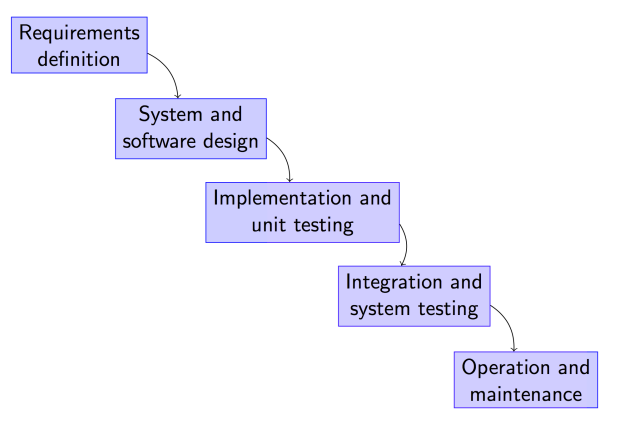
4
New cards
Prototyping
Way of tackling larger stages of other methodologies. Lower function prototypes used to test ideas and get feedback. Can lead to complete shifts.
5
New cards
Rapid Application Development
Heavy focus on tools to reduce costs and time (IDEs, GUI builders, DBMS). Planning and implementation steps intertwines. Deadline is prioritised over requirements.
6
New cards
Agile
Development centred on short sprints. Allows client engagement, rapid development, early bug catching.

7
New cards
Pair Programming Roles
Driver (Coder) and Navigator
8
New cards
When to use Nested Classes
These are classes within classes. When you have two tightly couples classes that rely heavily on each other as it is a lot of work to create functions to access the members. Occurs frequently in GUI programming.
9
New cards
Static Nested Class
Does not have access to instance members. Outer class must be public (or package private by default).

10
New cards
Inner Class
Does not have access to instance members. Outer class must be public (or package private by default).
11
New cards
Local Class
Defined (and only exists) within a block (usually a method). Cannot have access modifiers. Cannot access local variables (unless they are *final* or passed as arguments). Can access all members of outer class.
12
New cards
Anonymous Classes
Declared with no class name. Can be defined within a method, and argument of a method.
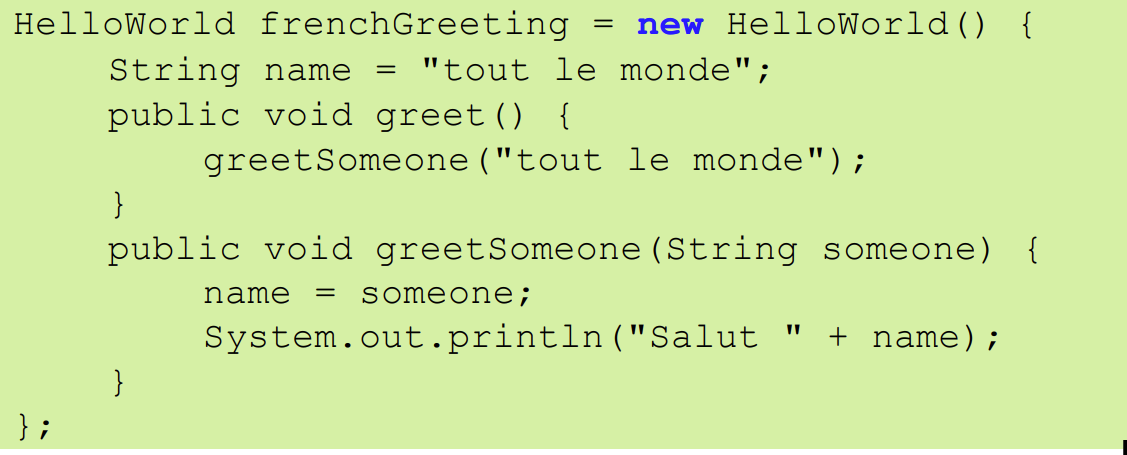
13
New cards
Concurrency
Allows multiple processes to be run at the same time (parallelism).
\
\
14
New cards
Threads
A lightweight process within a process. Multiple threads can be run at once, virtually (on single processor) or physically (on multi-core processor).
15
New cards
Liveness
The concern that code is performed correctly, in time.
16
New cards
Creating Threads in Java
In two ways: Using (and extending) *Thread* class, or using *runnable* interface.
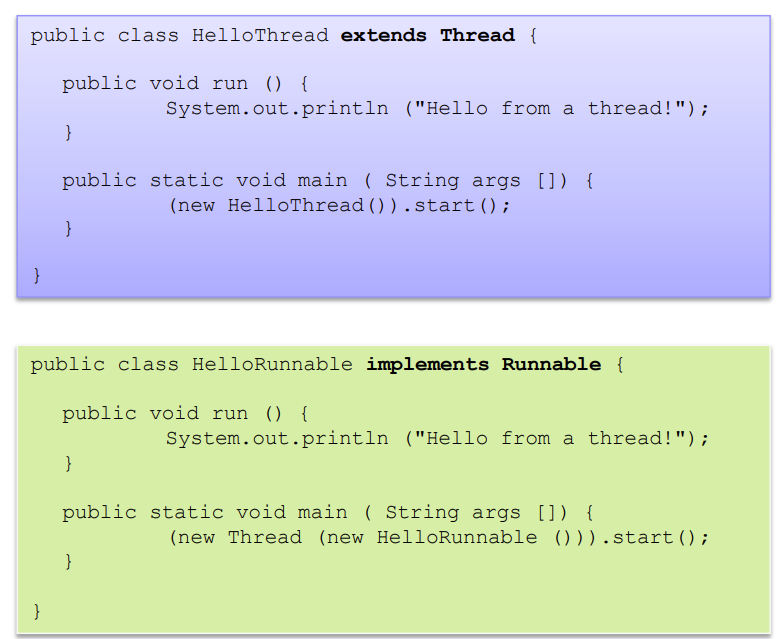
17
New cards
Java stopping a thread
Setting a flag - Loop will exit (and thread will stop) on the next iteration after done is set to true
or Interrupting - when isInterrupted() is called for this thread, it will stop unless the thread is sleeping/waiting.
or Interrupting - when isInterrupted() is called for this thread, it will stop unless the thread is sleeping/waiting.
18
New cards
Race conditions
Data synchronisation between threads causes issues. When the threads try to change data at the same time its a race condition.
19
New cards
Synchronisation
Add *synchronized* keyword to methods. When one thread is executing, other threads suspend execution until first thread is done with the object.
20
New cards
Atomic actions
Self contained and cannot be stopped when running. Either happen or do not happen. ¨ Reads and writes are atomic for all variables declared volatile, reads and writes are atomic for most primitive variables (all types except long and double).
21
New cards
Starvation
When a thread can’t gain regular access to shared resources as another thread is using it.
22
New cards
Livelock
Similar to deadlock, but both threads are too busy responding to each other to do work.
23
New cards
void wait();
waits for a condition to occur, must call from synchronised method/block.
Releases the lock and regains it using notify()
Releases the lock and regains it using notify()
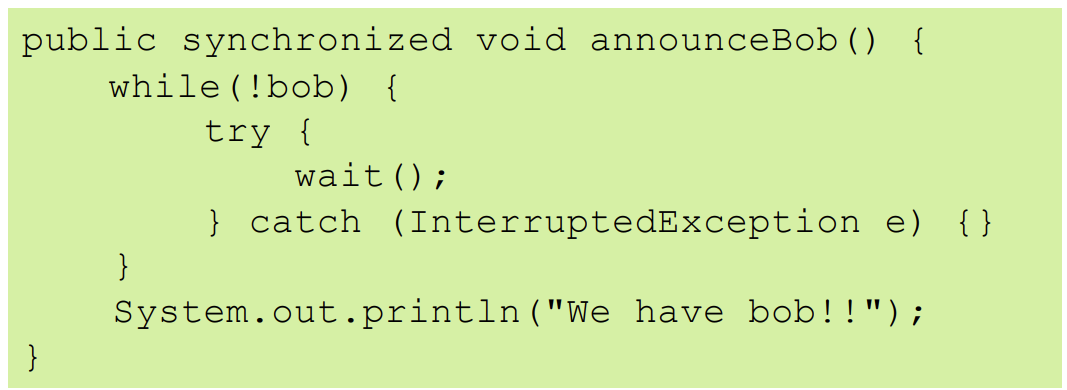
24
New cards
void wait(long timeStep);
waits for a condition for *timeStep* milliseconds, then returns, must call from synchronised method/block
25
New cards
void notify();
notifies a waiting thread a condition has occurred, must call from synchronised method/block (also void notifyAll();)
allows thread communication
allows thread communication
26
New cards
Version control
Records changes over time, recall specific versions later. Allows a project wide undo button. Allows support of multiple releases. Records responsibility for changes. Changes aren’t lost when overwritten.
27
New cards
What should we store in version control?
EVERYTHING needed if local machines died.
28
New cards
Centralised vs distributed repositories
As soon as you commit to a centralised repository others can see your changes whereas Developers must push changes and pull updates from distributed repositories.
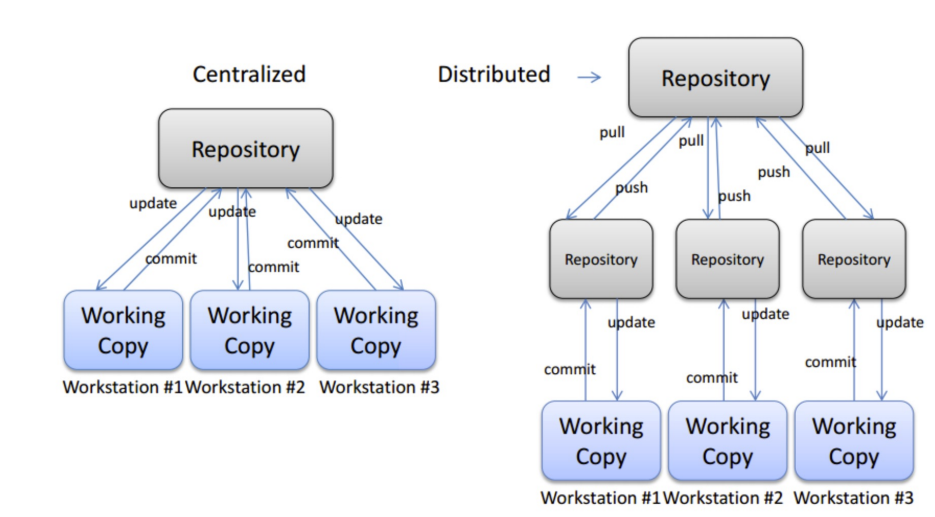
29
New cards
Strict locking (version control)
Only one person can change a file at any one time
30
New cards
Optimistic locking (version control)
All files can be changed but of any changes have occurred since last pull then you must address the changes before committing.
31
New cards
Version control and binary files
These are marked as non-mergable automatically, and manual merging must occur
32
New cards
33
New cards
What is polling
“while the event hasn’t happened, keep checking…”. Easy to implement but very wasteful.
34
New cards
Events
OS will notify program when event happens. More complex but better use of resources. Very useful in GUIs
35
New cards
Events in Java
Use delegation model with Sources, Events and Listeners.
36
New cards
Source (events)
Object that generates an event, typically in response to some change in state. Must register listeners to be notified of an event.
37
New cards
Listener (events)
An object that is notified of an event occurring. Must be registered and have methods to deal with notifications.
38
New cards
Event
an object that contains information about a state change in a source
39
New cards
Java event framework
Consists of two concrete classes, one abstract class (java.util.EventObject) and one interface (java.util.EventListener).
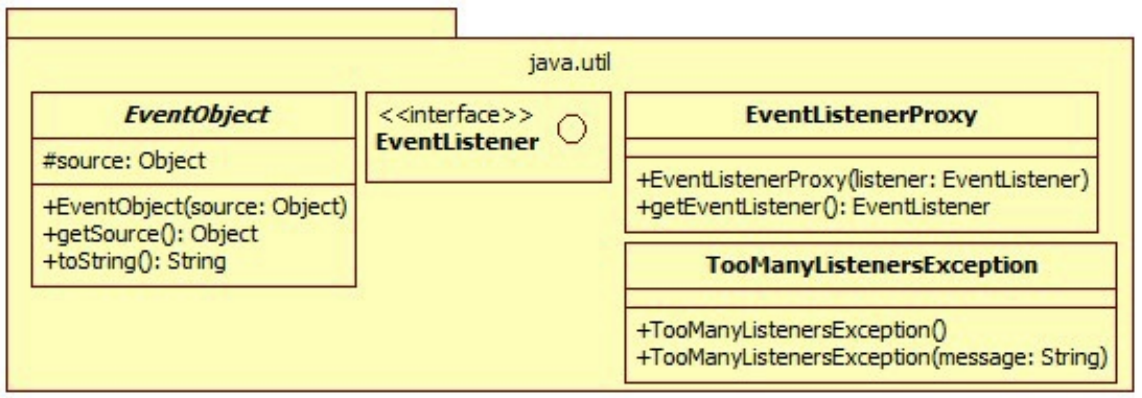
40
New cards
Listeners
Has a different method for each type of event notification.
These notifications are grouped together into categories represented by an event listener interface (extending java.util.EventListener) *EventCategoryNameListener.* These relate to a single event class typically.
To be notified of events, a class must implement a listener interface.
These notifications are grouped together into categories represented by an event listener interface (extending java.util.EventListener) *EventCategoryNameListener.* These relate to a single event class typically.
To be notified of events, a class must implement a listener interface.
41
New cards
event notification method
public void specificEvent (EventCategoryNameEvent e)
42
New cards
State Object
n All states related to an event should be captured in this object when the event occurs. The class of this object must be a subclass of *java.util.EventObject*, as a minimum it must record which object was the source of the event.
\
By convention this call is named EventCategoryNameEvent e ¨ E.g., ActionEvent e, KeyEvent e, ScannedRobotEvent e
\
By convention this call is named EventCategoryNameEvent e ¨ E.g., ActionEvent e, KeyEvent e, ScannedRobotEvent e
43
New cards
Concept of operations
A statement of goals and objectives of a system. Includes strategies, tactics, policies and constraints. Clear statement of responsibilities of those involved. Specifies how to develop, maintain and retire system.
44
New cards
Requirements analysis
Gathering requirements, analysing them, and documenting them
45
New cards
High-level design
Describes platforms, systems etc that the developed system will depend on. Typically has an architecture diagram.
46
New cards
Detailed design
Specifies how system will be constructed, e.g., what functions/objects/methods should be. You should be able to create tests off of this.
47
New cards
Integration testing
Testing after grouping together components.
48
New cards
Types of testing
Unit, Integration, System, User acceptance
49
New cards
System testing
Testing the entire system and ensuring it does not impair performance of wider environment
50
New cards
User acceptance testing
Performed in a user environment resembling production, using realistic data. Ensures delivered system meets user’s requirements and is ready for use. Validation rather than verification.
51
New cards
V-model
Way of approaching development. Highly structured, but not suitable where requirements might change as difficult to go back and change functionality when in testing stage.

52
New cards
Static testing
Assessing documents (review, walkthroughs, …)
53
New cards
Dynamic testing
Testing that involves executing program code. Whit, grey and black box testing.
54
New cards
Types of code coverage
Function, statement, decision, predicate.
55
New cards
Corner cases
Like edge cases but where many variables are at extremes. Most tests are focussed on typical system use so miss these situations. These are hard to replicate, so modern code is often instrumented to track how they occurred.
56
New cards
Purpose of Unit Tests
It is hard to test if something works, so you only disprove it doesn’t work. Test underlying hypothesis of developer that code works as intended.
57
New cards
Benefits of Unit Tests
Reduces time spent on debugging. Helps communicate intended use, how code should perform.
58
New cards
Right-BICEP
Right – are the boundary results correct? (or “right”)
B – are all the boundary conditions correct?
I – can you check the inverse relationships?
C – can you cross-check the results using some other means?
E – can you force error conditions to occur?
P – are the performance characteristics within bounds?
B – are all the boundary conditions correct?
I – can you check the inverse relationships?
C – can you cross-check the results using some other means?
E – can you force error conditions to occur?
P – are the performance characteristics within bounds?
59
New cards
Properties of good tests
ATRIP
Automatic, Thorough, Repeatable, Independent, Professional (high standard)
Automatic, Thorough, Repeatable, Independent, Professional (high standard)
60
New cards
How do you test tests?
By introducing bugs, it should fail as expected.
61
New cards
Unit test process
1\. Set up all conditions needed for testing (create any required objects, allocate any needed resources, …)
2\. Call the method to be tested on the object
3\. Verify that the object/class to be tested functions as expected
4\. Clean up after itself
2\. Call the method to be tested on the object
3\. Verify that the object/class to be tested functions as expected
4\. Clean up after itself
62
New cards
AssertEquals and Floating Points
Floating point values are not exact due to finite memory, so you should specify a tolerance.
*assertEquals (String msg, expected, actual, tolerance)*
*assertEquals (String msg, expected, actual, tolerance)*
63
New cards
Mock objects
Provide predictable placeholder objects that allow testing of methods as it can be difficult to otherwise test.
64
New cards
When should you use mock objects?
When the real object is: slow, non-deterministic, difficult to trigger, doesn’t exist yet, difficult to set up or uses a UI.
65
New cards
How to implement mock objects
1\. Use an interface to describe the object
2\. Implement the interface for production code
3\. Implement the interface in a mock object for unit testing
2\. Implement the interface for production code
3\. Implement the interface in a mock object for unit testing
66
New cards
Test suites
Allow multiple test classes to run as a single batch.

67
New cards
Test-driven development
Can help you design your code better and see code from user perspective.
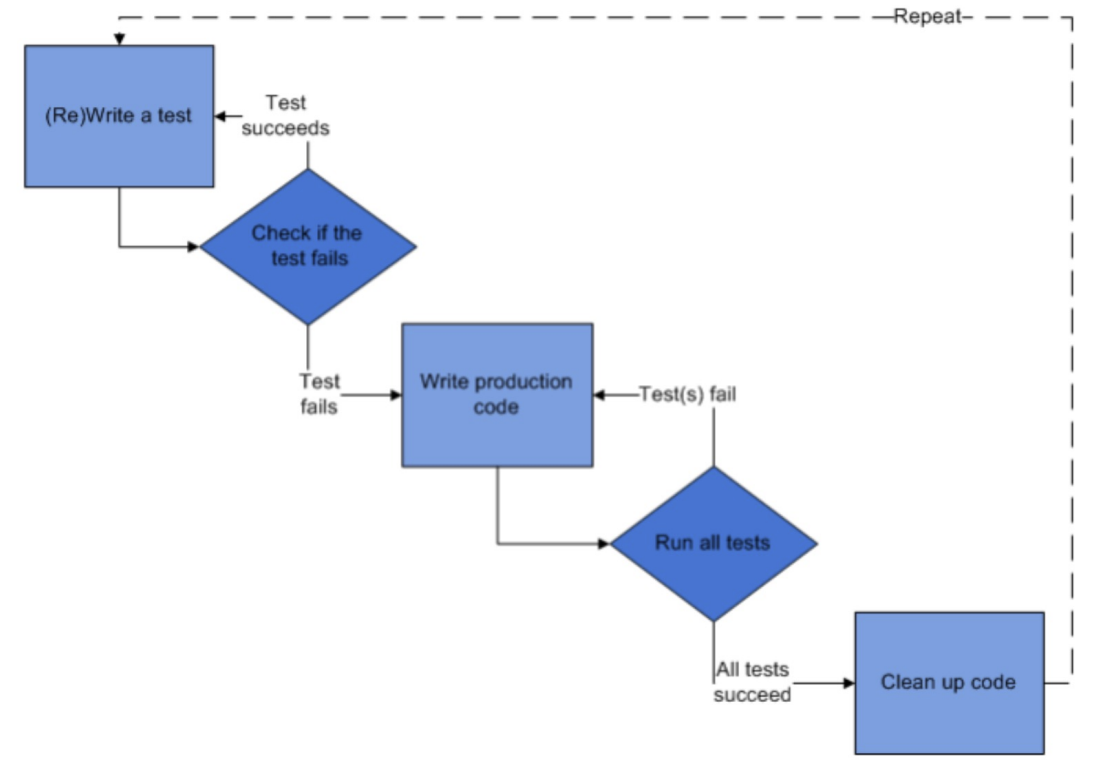
68
New cards
Invariants
Assertions about classes/objects that should not change e.g., bank account credits and debits match balance or measurements should be equal after conversions.
69
New cards
Design pattern
Meant to provide a general reusable solution to one type of problems during software development – they provide an architecture.
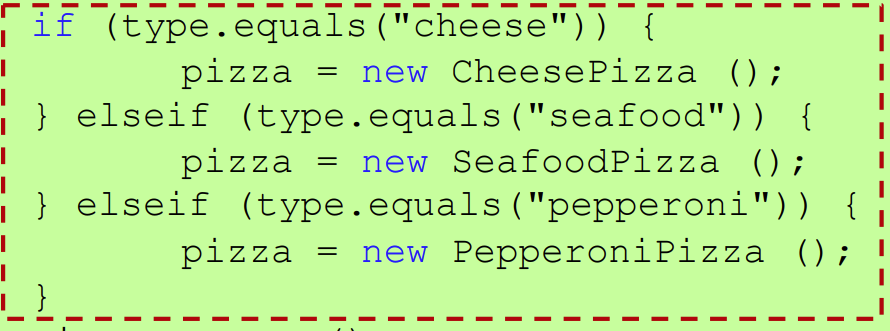
70
New cards
Creational Patterns
Object creation
71
New cards
Structural Patterns
Composition of classes and objects
72
New cards
Behavioral Patterns
interaction between objects
73
New cards
Factory Pattern
Defines an interface for creating an object, but lets subclasses decide which class to instantiate. It lets a class defer instantiation to subclasses.
\
Factory Pattern uses inheritance (extend a class and override a factory method) and gives you a complete object in one shot.
\
Factory Pattern uses inheritance (extend a class and override a factory method) and gives you a complete object in one shot.
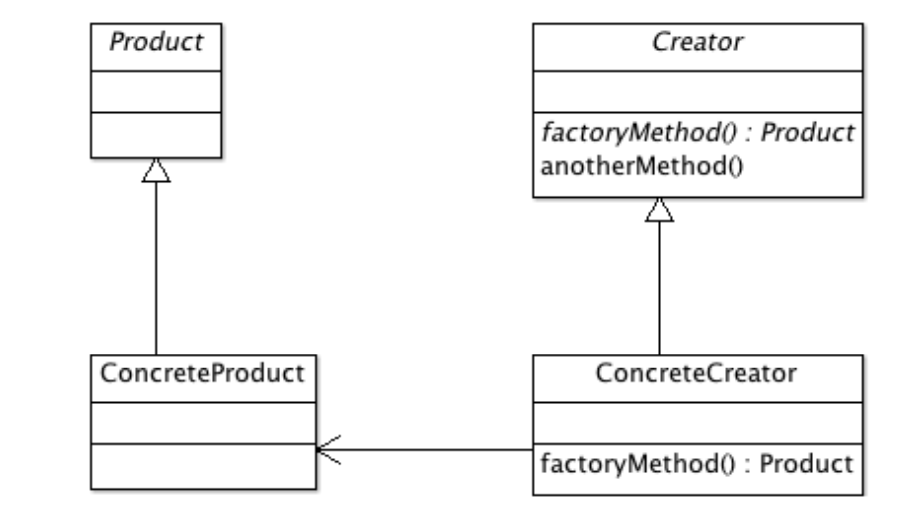
74
New cards
Abstract Factory Pattern
Provides an interface for creating families of related or dependent objects without specifying their concrete classes. Supports creation of different families. Supports creation of different families e.g., for different OS.
\
This uses composition (defines an abstract type for creating a family of products and lets subclasses decide how those products are produced) and returns a family of related classes.
\
This uses composition (defines an abstract type for creating a family of products and lets subclasses decide how those products are produced) and returns a family of related classes.
75
New cards
Builder Pattern
Separates the construction of a complex object from its representation so that the same construction processes can create different representations. Allows variation of products internal representation.
76
New cards
How do Builder Patterns work?
**Builder** specifies interface for creating parts of the object.
**ConcreteBuilder** object creates and assembles parts that make up product through builder interface.
**Director** object takes responsibility for construction process of object but delegates actual creation and assembly to Builder.
**Product** represents complex object that is created by **ConcreteBuilder** object. Consists of multiple parts that are created separately by ConcreteBuilder.
**ConcreteBuilder** object creates and assembles parts that make up product through builder interface.
**Director** object takes responsibility for construction process of object but delegates actual creation and assembly to Builder.
**Product** represents complex object that is created by **ConcreteBuilder** object. Consists of multiple parts that are created separately by ConcreteBuilder.
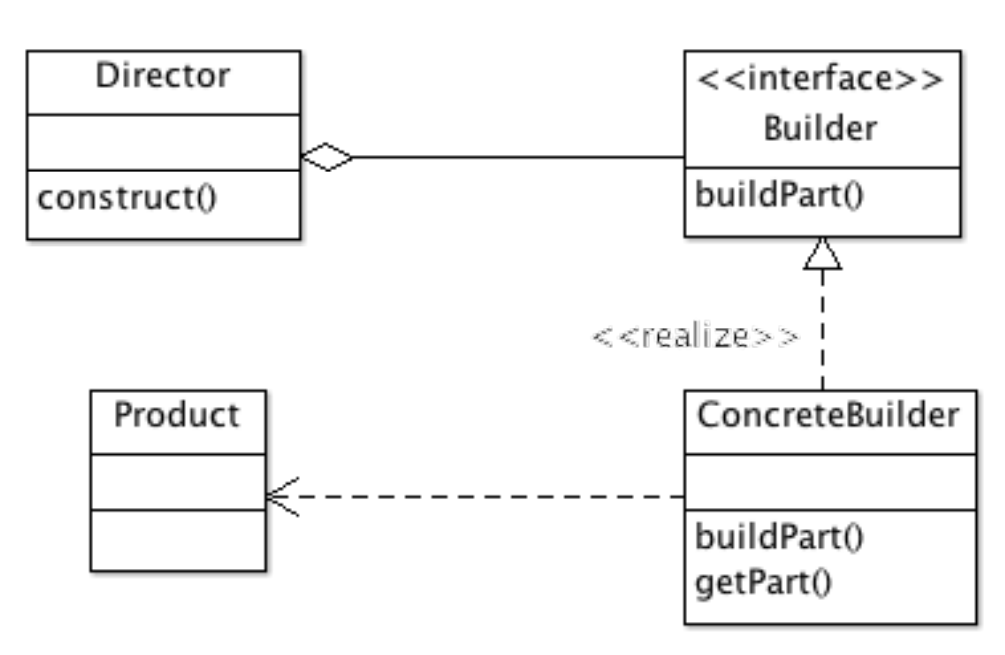
77
New cards
Advantage and Use of Builder pattern
Encapsulates the way a complex object is constructed. Unlike one-step factories, allows objects to be constructed in a multistep/varying process. Hides the internal representation of the product from the client.
\
Useful when: “Considering that you order a drink (Coffee or Tea) in Costa Coffee. The waiter tells the builder I need a drink - large coffee with caramel flavour.”
\
Useful when: “Considering that you order a drink (Coffee or Tea) in Costa Coffee. The waiter tells the builder I need a drink - large coffee with caramel flavour.”
78
New cards
Factory vs Abstract Factory vs Builder Patterns
\
* Factory pattern constructs a complete object in one shot
* Abstract Factory pattern returns a family of related classes
* Builder pattern constructs a complex object step by step
* Factory pattern constructs a complete object in one shot
* Abstract Factory pattern returns a family of related classes
* Builder pattern constructs a complex object step by step
79
New cards
Singleton Pattern
Ensures that a class has only one instance, and provides a global point of access to it. e.g., window managers, file systems.
80
New cards
How to create a Singleton Pattern
Static member: Create a private static variable of the Singleton class. This is the only instance of Singleton class.
Private constructor: Create a private constructor for making sure an outer class can NOT instantiate object from the Singleton class.
Static public method: Create a global point of access to get a Singleton instance.
\
May be resource heavy so not always used.
Private constructor: Create a private constructor for making sure an outer class can NOT instantiate object from the Singleton class.
Static public method: Create a global point of access to get a Singleton instance.
\
May be resource heavy so not always used.
81
New cards
Lazy vs eager instantiation
Eager - Creates instance at time of class loading
Lazy - Instance is not created until getInstance() is called for first time.
Lazy - Instance is not created until getInstance() is called for first time.
82
New cards
Decorator Pattern
Attaches additional behavioural responsibilities to an object dynamically. Decorators provide a flexible alternative to subclassing for extending functionality.
You can use one or more decorators to wrap an object
You can use one or more decorators to wrap an object
83
New cards
The Command Pattern
Encapsulates a request as an object to let you use objects as parameters with different requests. Used widely in GUI design.
e.g., Client sets up a remote control so a light activator (receiver) is bound to a particular ConcreteCommand (button).
Invoker then interacts with the button and the resulting behaviour is determined by the client.
e.g., Client sets up a remote control so a light activator (receiver) is bound to a particular ConcreteCommand (button).
Invoker then interacts with the button and the resulting behaviour is determined by the client.
84
New cards
Invoker (Command Pattern)
Holds a command and asks the Command to carry out request by calling execute() method
85
New cards
Command (command pattern)
Declares interface for all commands (allows concrete implementers to be interchangeable)
86
New cards
ConcreteCommand (command pattern)
Defines binding between action and receiver. Once bound the invoker can make a request of the command object (*execute()*) resulting in ConcereteCommand calling one or more actions on the receiver.
87
New cards
Receiver (concrete classes)
Preforms the work required to carry out the request. Any class can be a receiver.
88
New cards
Client (command pattern)
Instantiates the *ConcreteCommand* and sets its *Receiver*.
89
New cards
Pattern Overview
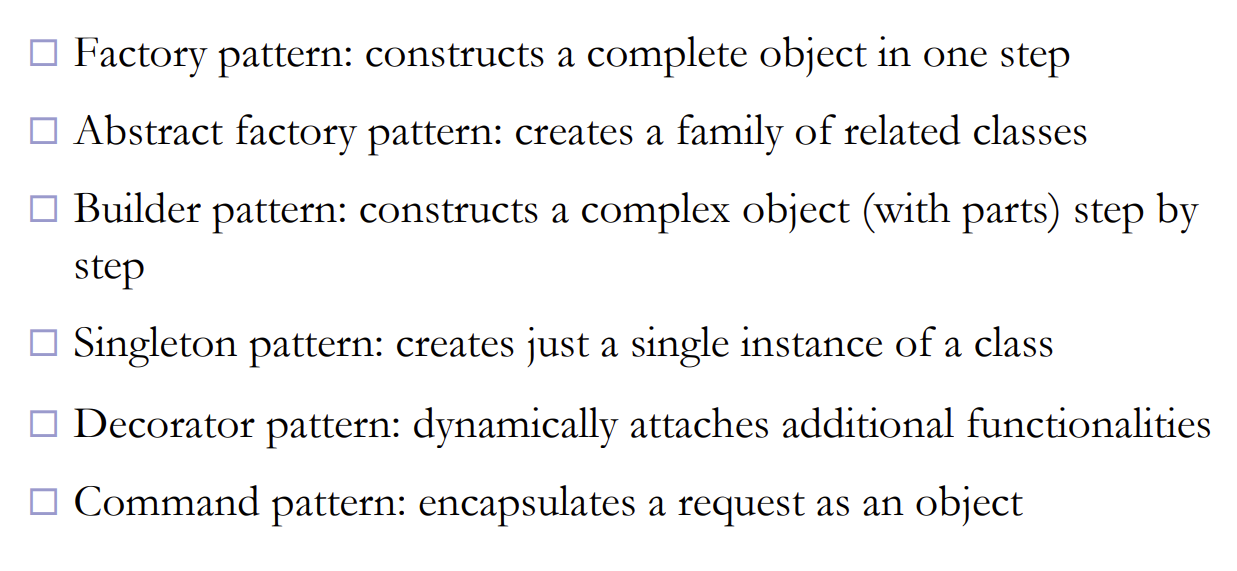
90
New cards
OOP and Patterns
Encapsulate what varies.
Program to an interface, not an implementation.
Favour ‘object composition’ over class inheritance.
Classes should be open for extension, but closed for modification.
Depend on abstractions, not concrete classes.
Program to an interface, not an implementation.
Favour ‘object composition’ over class inheritance.
Classes should be open for extension, but closed for modification.
Depend on abstractions, not concrete classes.
91
New cards
Java generics
Facilitate generic programming style that allows algorithms to be written for different types and specified later.
Uses **Type parameters** to provide a way to re-use code with different inputs.
Uses **Type parameters** to provide a way to re-use code with different inputs.
92
New cards
Advantages of Java Generics
Leads to safer code, as bugs that appear at runtime can be detected at compile time.
93
New cards
Common type parameter names
E - element
K - key
N - number
T - type
V - value
S, U, V - 2nd, 3rd, 4th types
K - key
N - number
T - type
V - value
S, U, V - 2nd, 3rd, 4th types
94
New cards
Three Types of Generics
Generic types, generic methods, generic constructors
95
New cards
Bounded types
Writing a class/methods to operate with generic types but exhibiting certain properties.
Upper bound = *extends*
Lower Bound = *super*
\
e.g., *Public void genericMethod(S input)* means to legally compile, the *genericMethod* argument must be a Number or a subtype of it
Upper bound = *extends*
Lower Bound = *super*
\
e.g., *Public void genericMethod(S input)* means to legally compile, the *genericMethod* argument must be a Number or a subtype of it
96
New cards
Type erasure
Ensures backwards compatibility, as generics were added late. Compiler removes type information from parameters and arguments within generic classes/methods.
\
e.g., Use *generic class Spoon* to create *Spoon*
This is converted into type *Spoon* (raw type - generic class name minus type argument).
\
e.g., Use *generic class Spoon
This is converted into type *Spoon* (raw type - generic class name minus type argument).
97
New cards
Heap Pollution
The situation in which a variable of a declared parametrised type refers to an instance not of the type.
98
New cards
Collections
An object that groups multiple elements into a single unit. Can be iterated over using *for-each*, although needs an *Iterator* object to remove elements.
e.g., poker hand = collection of cards
e.g., poker hand = collection of cards

99
New cards
Collection vs Map
Collection - A group o objects known as elements - *public interface Collection*
Map - a group of objects where each object maps keys to values - *public interface Map
Map - a group of objects where each object maps keys to values - *public interface Map
100
New cards
Set interface
Contains no duplicate elements. If two of these contain the same elements then they are treated equally.